Bengal cat colors are widely varied. In order to rank them effectively, we will separate the colors into groups based on the base coat color. They also come in two main patterns, spotted or marbled. Spotted are more common than marbled. The longhair variant, called “Cashmere,” is relatively new to the breed. The International Cat Association (TICA) officially recognized and accepted them for Championship in 2017. The shorthair variety gained Championship status in 1991.
Championship status means the cats can compete in shows to gain titles. TICA does not accept all colors as of 2023. They did recently accept charcoals for Championship in 2020. The Cat Fancier’s Association (CFA) in the U.S. recognizes and accepts all colors and patterns for Championship. Both registries consider charcoal to be a pattern rather than a color. However, for the purposes of this article, it counts as a color. A registry in the cat fancy is an organization that registers cats to keep track of their pedigree (or family tree). They also host cat shows where cats compete!
A Quick Genetic Lesson in Cat Coat Colors
What color a cat appears when you look at it (phenotype) all comes down to genetics. Bengal cat colors are no different. Each color has specific genes that determine whether the cat is a certain color or not. For instance, a blue cat will be homozygous recessive for dilution. That’s a lot of big words! Let’s break it down further.
What are genes?
A gene is the basic building block of DNA. Each gene has two alleles, one from the mother and one from the father. Genotype is the name for the pair of alleles. Homozygous means both alleles are the same, while heterozygous means the alleles are different. A color panel determines what genes a cat carries. The locus is where the gene is located on the DNA block. The UC Davis Veterinary Genetics Laboratory (VGL) researches DNA on all kinds of animals!
Examples of Bengal Cat Color Genes
Dilution removes some color from the coat, causing a muted or pastel appearance of the original color. Letters re[resent the individual color genes when talking about DNA. The letter (d) represents dilute, while the non-dilute is (D). A non-dilute cat is (D/D), while a dilute cat is (d/d). Dilute is recessive, which means in order for a cat to be blue, it must have two copies of the dilute gene. A dominant gene requires only one copy to be visible. We will discuss dilution more below.
Some colors, like silver, are incompletely dominant. This means they only change part of the color. Silver only affects the base coat, and the pattern remains the same. A Bengal that would normally be brown that has the silver gene will have a silvery gray base coat but keep its black markings.
Let’s jump into the rarest to most common Bengal cat colors! There are seven color classes.
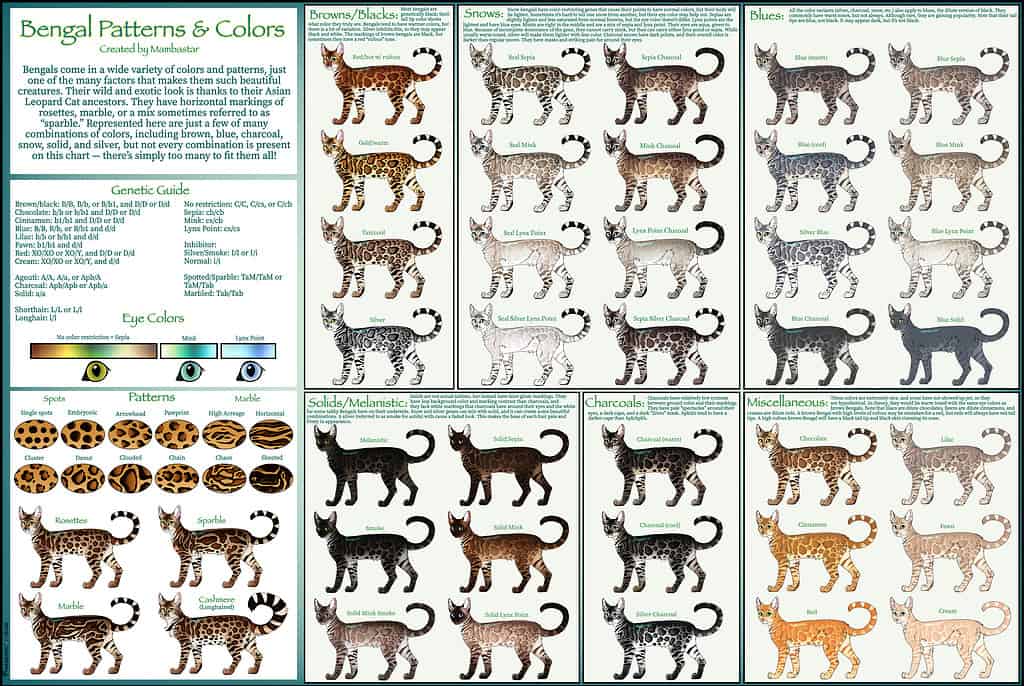
Bengal cats come in a huge variety of colors and patterns. Some of them are so rare, no photos exist yet.
©Mambastar / DeviantArt – License
#1 Miscellaneous – The Rarest Bengal Cat Colors
Some Bengal cat colors are so rare no photos of them exist yet. This group includes chocolate, lilac, cinnamon, fawn, red, torbie, and cream. These colors are becoming more popular as breeders work with them and learn about the possibilities. Each of these colors is equally rare as of 2023.
Chocolate and Lilac Bengal Cats
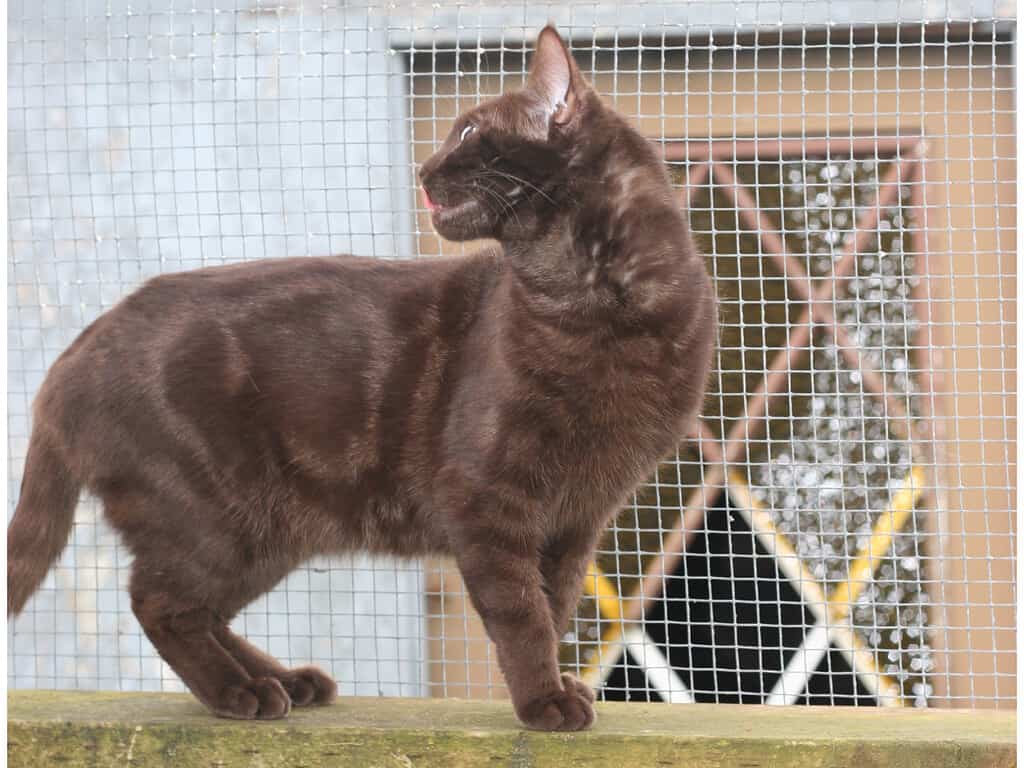
Chocolate (b) is a mutation of black. A cat whose phenotype is chocolate will have a genotype (b/b). The chocolate gene replaces all the black in the coat with dark chocolate brown. Cocoa of Cranberry Coast Cats, picture to the right, is a solid chocolate Bengal cat with a marble pattern. If the chocolate cat is also dilute, the cat appears lilac. Lilac is a soft purplish color. Some breeds, like Tonkinese, call it platinum.
Cinnamon and Fawn Bengal Cats
Cinnamon (b1) is a further mutation of black. It replaces all the black pigment in the coat with soft, pale orange. A cat whose phenotype is cinnamon will have a genotype of (b1/b1). Combining cinnamon with dilute results in fawn. Cinnamon-colored Bengals exist in small numbers. Other breeds also come in cinnamon and fawn. Cinnamon/fawn Bengal cats look similar to red/cream, but they are not the same. Technically, a cat could be both cinnamon and red at the same time!
Red, Torbie, and Cream Bengal Cats
This Bengal cat color group provides a beautiful cat that reminds one of the common house cats.
Where Did the Red Come From?
Auroralights Bengals, owned by Cathy Potter, has been working extensively with the red Bengal color since 2015. She began her venture with a red male cat named Jasper. She determined that this cat had the qualities and personality she wanted, along with the color. Since then, she has created Bengals in red and torbie. Torbie is similar to a tortoiseshell cat (tortie). Torties are solid, while torbies have a tabby pattern.
She also discovered an entirely new color called she calls “blaze.” This new Bengal cat color arrived with the birth of a kitten that appeared white with red spots. Potter called him Caesar and kept him to see how he would grow. It turned out that Caesar was actually both silver and red at the same time.
The red coloration was brought in through other breeds in her program, but the actual breed is still undisclosed by Potter. Other breeders used red domestic shorthair cats like the one pictured below.
How Red Works is Special!

Red (orange) is a common color for domestic cats.
©Hisashi from Japan / CC BY-SA 2.0 – License
Any color of Bengal can combine with red, as seen with Caesar. This is because red is a “sex-linked gene.” Sex-linked means that the gene is carried on either X or Y allele that genes determine if a cat is male (X/Y) or female (X/X).
Red (O) and black (o) both link to X. A male cat can only be red (XO/Y) or black (Xo/Y). That’s because he has only one X allele. Females, who have two X alleles, can be red/red (XO/XO) or red/black (XO/Xo). A female that is (XO/Xo) is a tortie cat. The tortie phenotype is a solid black cat with red splotches throughout the coat. A cat that is both red and dilute is called cream. A dilute tortie Bengal will be blue with cream splotches.
The Rarest Bengal Cat Colors are Becoming More Common!
Although the miscellaneous group of Bengal cat colors is still extremely rare, their popularity is on the rise. More and more breeders and Bengal enthusiasts around the world are falling in love with these unique and special colors! Their numbers are increasing as more people discover them.
#2 Solid/Melanistic and Smoke – The Darkest Bengal Cat Colors
Solid/Melanistic
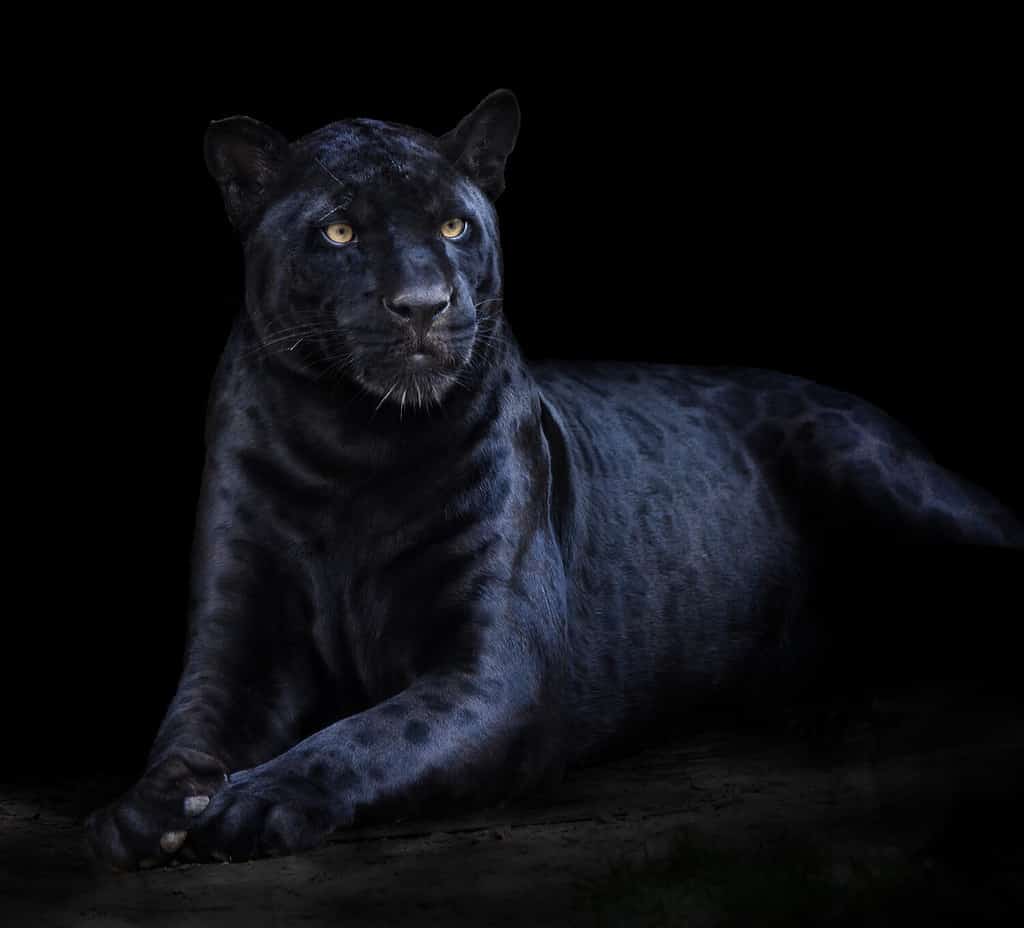
Jaguars can also be melanistic and have ghost spots, like solid Bengals.
©Xyo/Shutterstock.com
Melanistic is a term that means an increase in black or nearly black pigment within the skin, hair, fur, and/or feathers of an animal. Many species exhibit this genetic trait, such as tigers, leopards, and jaguars (pictured above). Melanistic in Bengals is also called solid (a) because the cat is all one color.
Agouti (A) is the term for the tabby pattern in cats. Agouti is dominant, while solid is recessive, like dilute. A Bengal must have two copies (a/a) to have the solid phenotype. Solid can be combined with any color! If the Bengal is (A/a), they carry solid and can produce solid when bred to a solid or another carrier. Solid Bengals have a “ghost” pattern seen only in certain lighting conditions. Many people love this Bengal cat color and seek these unique cats exclusively. Torbie, however, can only be a female that is not solid (A/A or A/a).
Smoke (aka Silver Smoke)
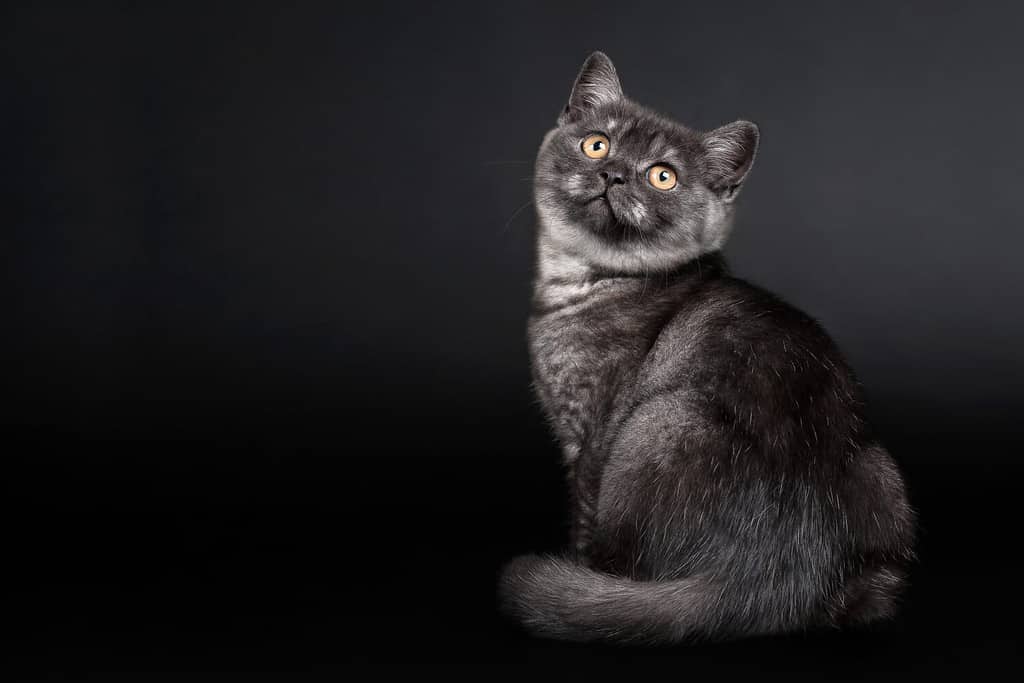
Bengal coats that are smoke-colored feature a dark top coat and a white undercoat.
©dien/Shutterstock.com
Smoke is the term that refers to a silver Bengal that is also solid (I/I or I/i and a/a). These cats have a brilliant white undercoat, while the top coat is dark black. British shorthairs also come in silver smoke, like the one pictured above. A smoke Bengal cat will still have a ghost pattern.
#3 Blue – One of the Pastel Bengal Colors

This group is a little tricky because blue is caused by dilution (d), as previously discussed. We already learned that chocolate, cinnamon, and red can all be diluted, as well. However, blue Bengals are more common than any of those colors. This puts them in their own group. Blue Bengals are brown Bengals with two copies of dilution (d/d). Blue can be combined with many other colors, as well. Reports of blue snow Bengals and blue charcoal Bengals have been seen. Dilution causes lessened pigment in the skin and fur. Kind of like adding cream to coffee; the color lightens significantly.
Rachael Monson of Nemera Bengals was one of the first breeders in the U.S. to have this beautiful Bengal cat color. Monson’s second litter from her cat, G2 Shawnee, was born on July 31, 2013. Of the three kittens, one was a blue-spotted G3 female. She was later adopted and named Monkey. Not only was she one of the first blues in the U.S., but she was also the first early-generation (EG) blue Bengal in the world! In the photo above, Monkey is about six months old.
#4 Charcoal – The Super Hero Bengal
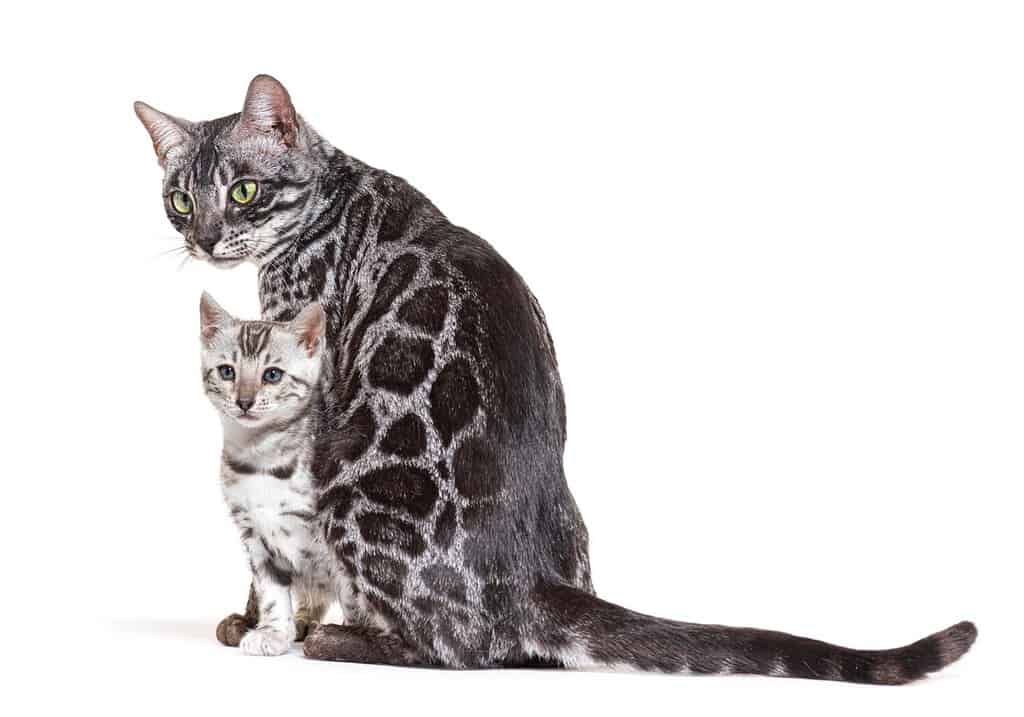
Charcoal coats can come in nearly every color.
©Eric Isselee/Shutterstock.com
Charcoal is technically a pattern that affects the Bengal cat’s color. Sometimes called the Super Hero Bengal, charcoal is characterized by a darker mask on the face and a dark “cape” down the back. The gene that creates charcoal is a special type of agouti brought in from the Bengals’ Asian leopard cat ancestors. Dubbed “wild agouti,” it is represented by (Apb). A charcoal Bengal can be (Apb/a or Apb/Apb).
Elysian Bengals, owned by Meghan Waals, is one of the breeders who specialize in charcoal Bengals. In fact, Waals campaigned for the acceptance of charcoal Bengals for Championship status with both TICA and CFA. She also specializes in silver Bengals. The photo above shows a charcoal silver spotted mother Bengal with her silver kitten. Charcoal can combine with nearly every Bengal coat color. Waals is the premier breeder for charcoals. She has produced charcoals in nearly every color imaginable, including the highly sought-after charcoal snow Bengal.
#5 Silver – The Bengal With a Lack of Color
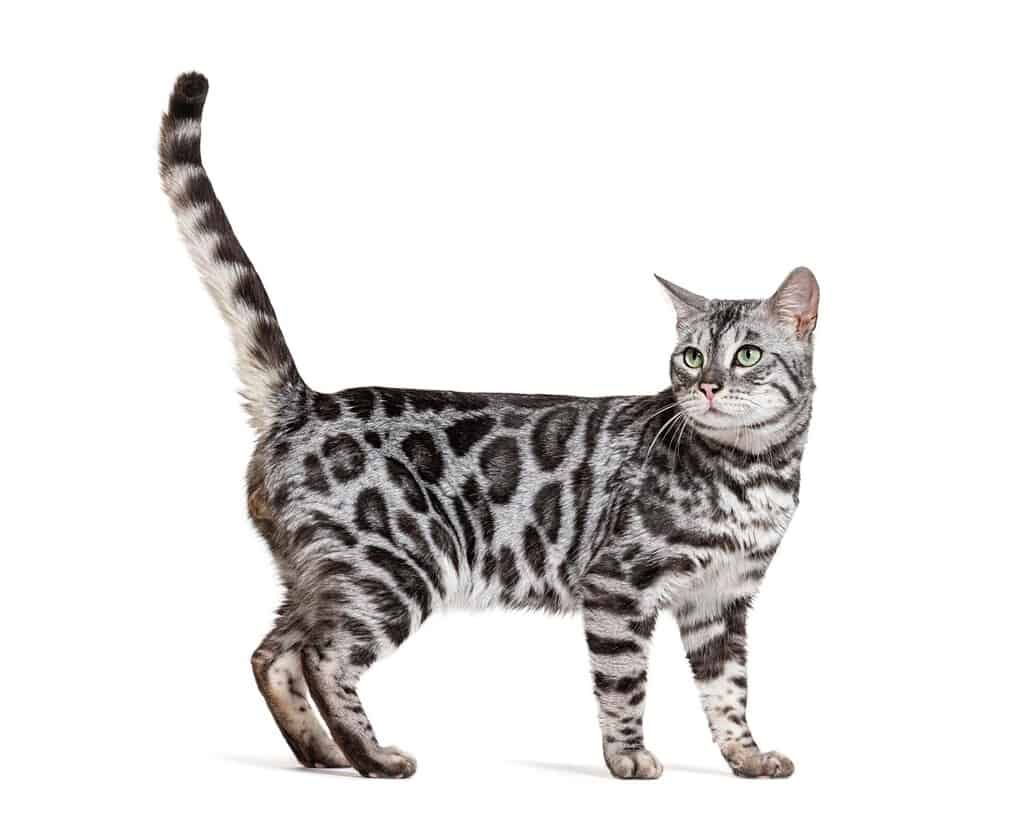
Tarnish describes a silver coat where some base color shows through.
©Eric Isselee/Shutterstock.com
Silver (I) is a special gene because it is incompletely dominant to the base color (i). Silver is actually a lack of color. It works by removing the pigment from the base color of the coat. It doesn’t affect the pattern. A silver Bengal could be (I/I) or (I/i). If they are homozygous dominant (I/I), every single kitten they produce will be silver. That’s because it only takes one silver allele to have a silver phenotype. The use of American shorthair cats for outcrossing is largely responsible for bringing silver into the Bengal breed.
Tarnish is when some base color shows through on a silver Bengal. This is undesirable in shows and causes a loss of points. Tarnish is usually seen on the toes or the back of the legs, or on the face. Some silvers are more tarnished than others. Some breeders believe that this is caused by breeding silvers to other colors or when silvers are heterozygous (I/i).
Silver is one of the most common Bengal colors. One of the best silver breeders in the world (now retired) was Joshua Dabbs of Rowan Bengals. This was Waals’ mentor.
#6 Snow – The Snow Leopard Bengal
Snow Bengals are the second most popular Bengal cat colors. Snows come in three major types. Snow combines with any other color except brown. Snow refers to any Bengal which is homozygous recessive for the colorpoint restriction gene (c/c). Siamese, Ragdoll, and Burmese cats all have colorpoint restriction genes. Essentially, this gene restricts color to the coldest parts of the body: face, ears, nose, paws, and tail. Snow Bengals are born pure white, or nearly so. Inside the womb, color is restricted entirely because the body is all at the same temperature. As snow Bengals grow, their color starts to come in at the points. A snow Bengal’s pattern continues to darken as they age until about two years old.
Seal Lynx Point Snow Bengal Cats
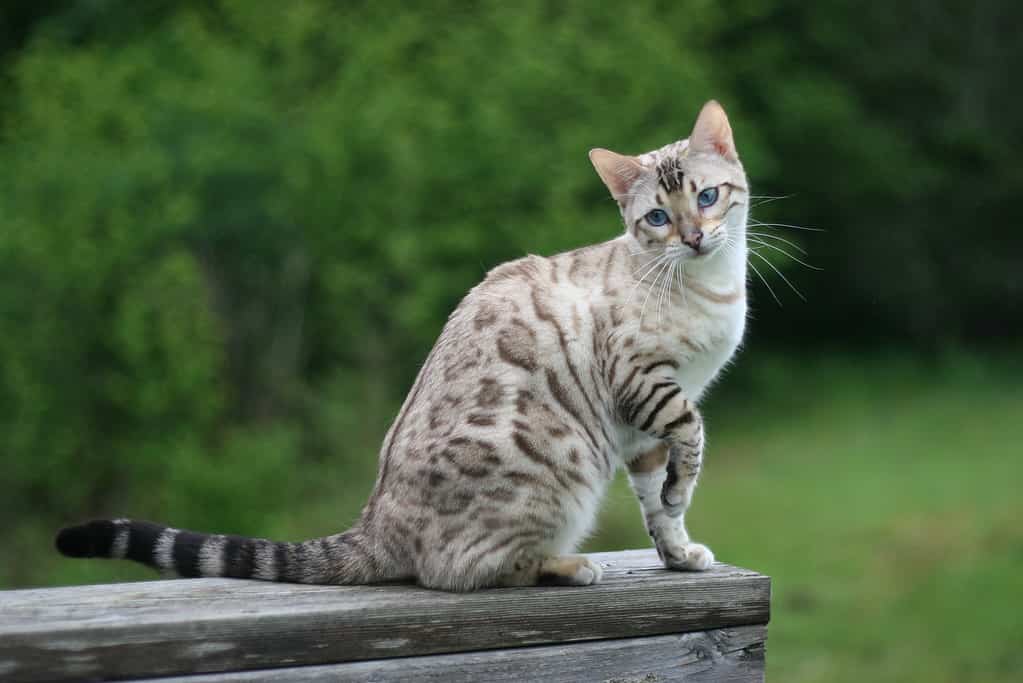
Seal Lynx Point (cs), or the Siamese gene, is the lightest of the snow varieties. These cats will always have blue eyes, regardless of what additional colors they are. Their genotype is (cs/cs). This beautiful girl pictured above is Erelae (AIR-uh-lay). Bred by Wildwood Bengals (retired) and owned by Monson, she was a top-winning show cat. Seal Lynx Points can be any other color, including blue and charcoal. Charcoal snows are very popular because the color of the pattern becomes much darker.
Seal Sepia Snow Bengal Cats

Seal sepia snow Bengals can be mistaken for brown Bengals because their pattern is often very dark.
©Nynke van Holten/Shutterstock.com
Seal sepia (cb), or the Burmese gene, is the darkest of the snow genes before adding any other mutations. These cats have green or gold eyes. This Bengal cat color is sometimes mistaken for brown when the pattern is especially dark (as seen in this Bengal above). You can tell the difference because the snow Bengals always have a white undercoat. Sepia is the rarest of the snow base colors because breeders use them to create seal mink kittens rather than more seal sepia Bengals.
Seal Mink Snow Bengal Cats
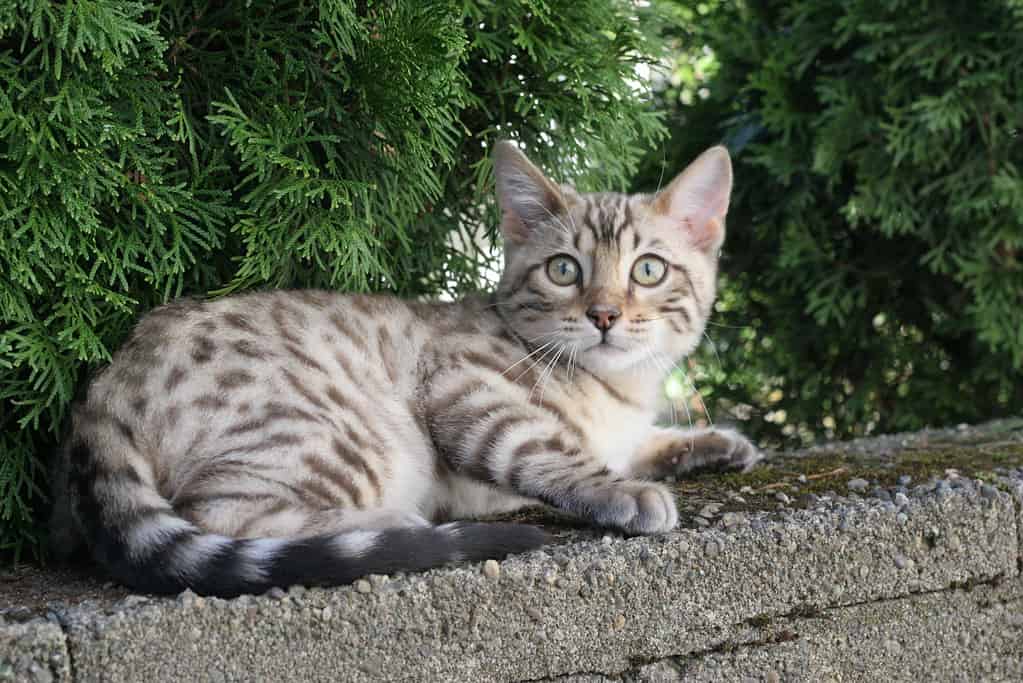
Seal mink (cs/cb) snow is a combination of the other snow Bengal cat colors. This type of combination is co-dominance. Both colors are equally dominant and combine to create a new color. Seal mink Bengals have aqua eyes, a mix of blue and green. If the sepia parent/carrier has gold eyes, this trait can pass on. This trait is seen in the seal mink Bengal above, Tate. Bred by Nemera Bengals, he went on to become a stud cat for Boardwalk Exotics, owned by Stephanie and Jorja Mulder in Canada. The seal mink Bengal cat color is very popular all over the world!
Snow Bengal Show Restrictions
Snow Bengal breeders must confirm the correct registration of their cats. Most breeders rely on color panels to ensure they have correctly identified their snow Bengal’s color. Their eye color must match the standard for their color group. A standard is a registry’s requirement for the breed. If a Bengal fails to meet the standard, they can lose points or even be disqualified. The colorpoints must not be significantly darker than the body pattern color, except in the case of charcoals.
#7 Brown – The Most Common Bengal Cat Color
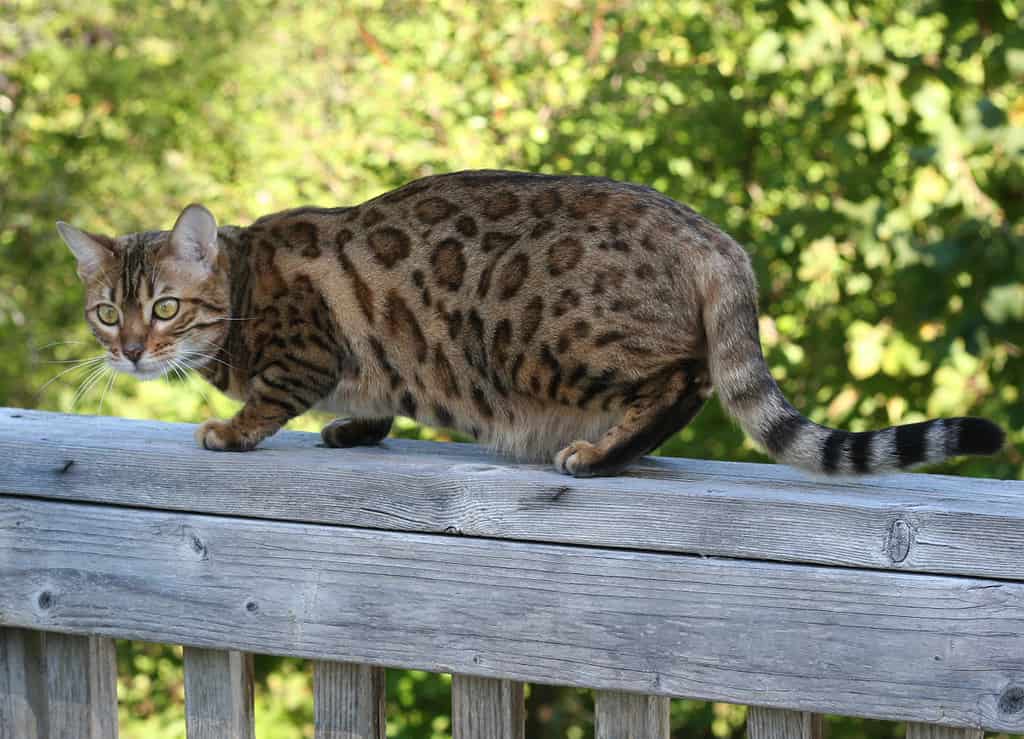
When most people think of a Bengal, they picture a brown spotted Bengal like Citrine, pictured above. Bred, raised, and shown by Monson, this cat is 10 years old as of 2023 and still lives with Monson.
Brown Bengals were the original color created by crossing domestic cats with Asian leopard cats. They are the single most popular and numerous of the Bengal cat colors. This is also the most genetically basic color. There are no mutations, except in the case of charcoal. These beautiful creatures can have green to gold eyes. Brown Bengals can be any shade of brown, from warm, reddish brown to dark earthy brown. There are so many variations of brown Bengals!
The registries refer to brown Bengals (and silvers) with black as a modifier. Registration papers list them as Brown (Black) Spotted/Marble Tabby. The reason for this is the agouti gene, which is technically on the black locus. Brown Bengals can carry any of the other colors (except silver) and produce them when paired with the right mate. This is why color panels are important tests for Bengal breeders to use. They help them determine the best matches!
Summary of Bengal Cat Colors: Rarest to Most Common
| Rank | Bengal Cat Color |
| #1 | Miscellaneous (Chocolate, Lilac, Cinnamon, Fawn, Red, Torbie, Cream) |
| #2 | Solid/Melanistic and Smoke |
| #3 | Blue |
| #4 | Charcoal (technically a pattern that modifies color) |
| #5 | Silver |
| #6 | Snow (Seal Lynx Point, Seal Mink, and Seal Sepia) |
| #7 | Brown |
The photo featured at the top of this post is © iStock.com/andreaskrappweis
Thank you for reading! Have some feedback for us? Contact the AZ Animals editorial team.






